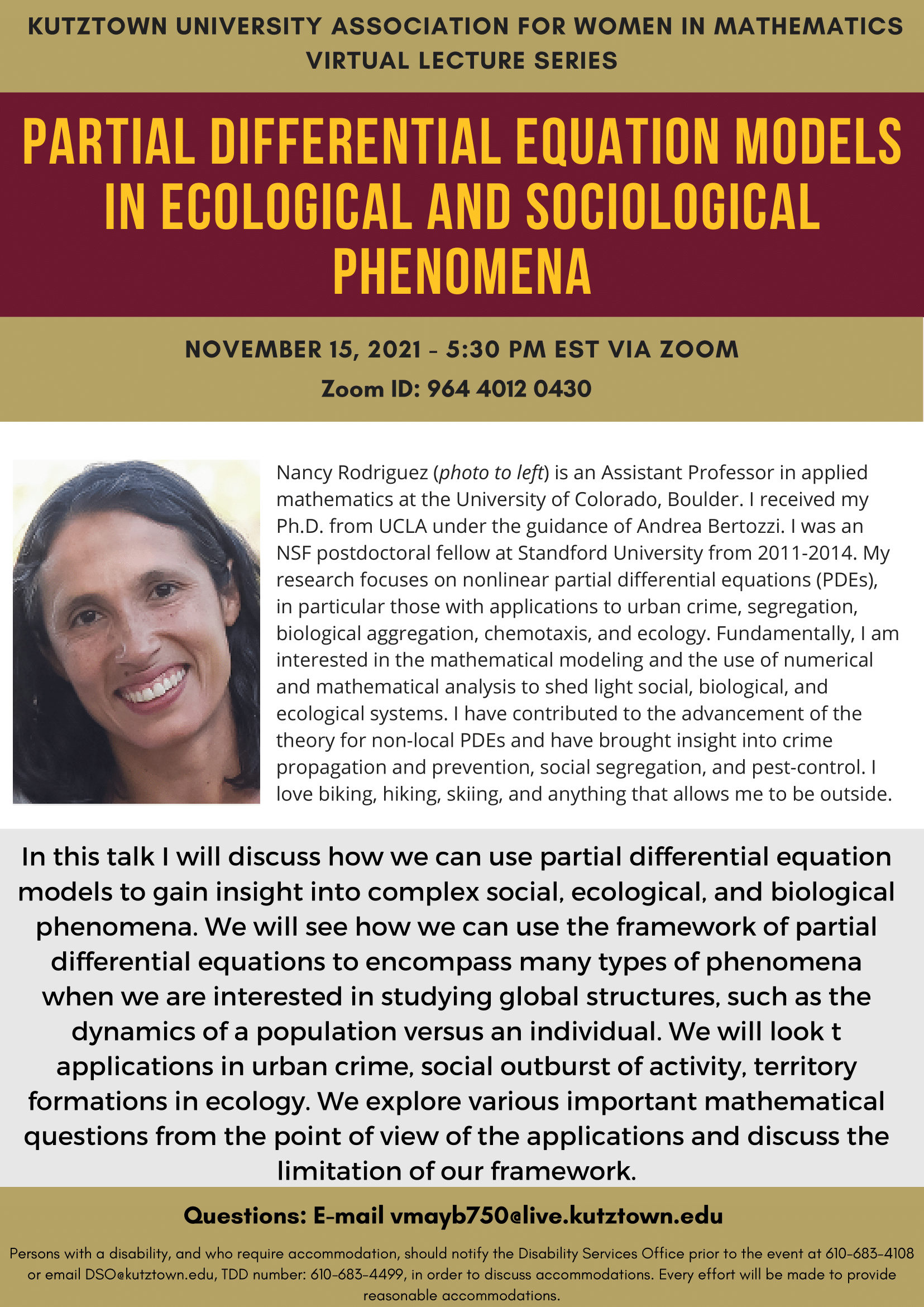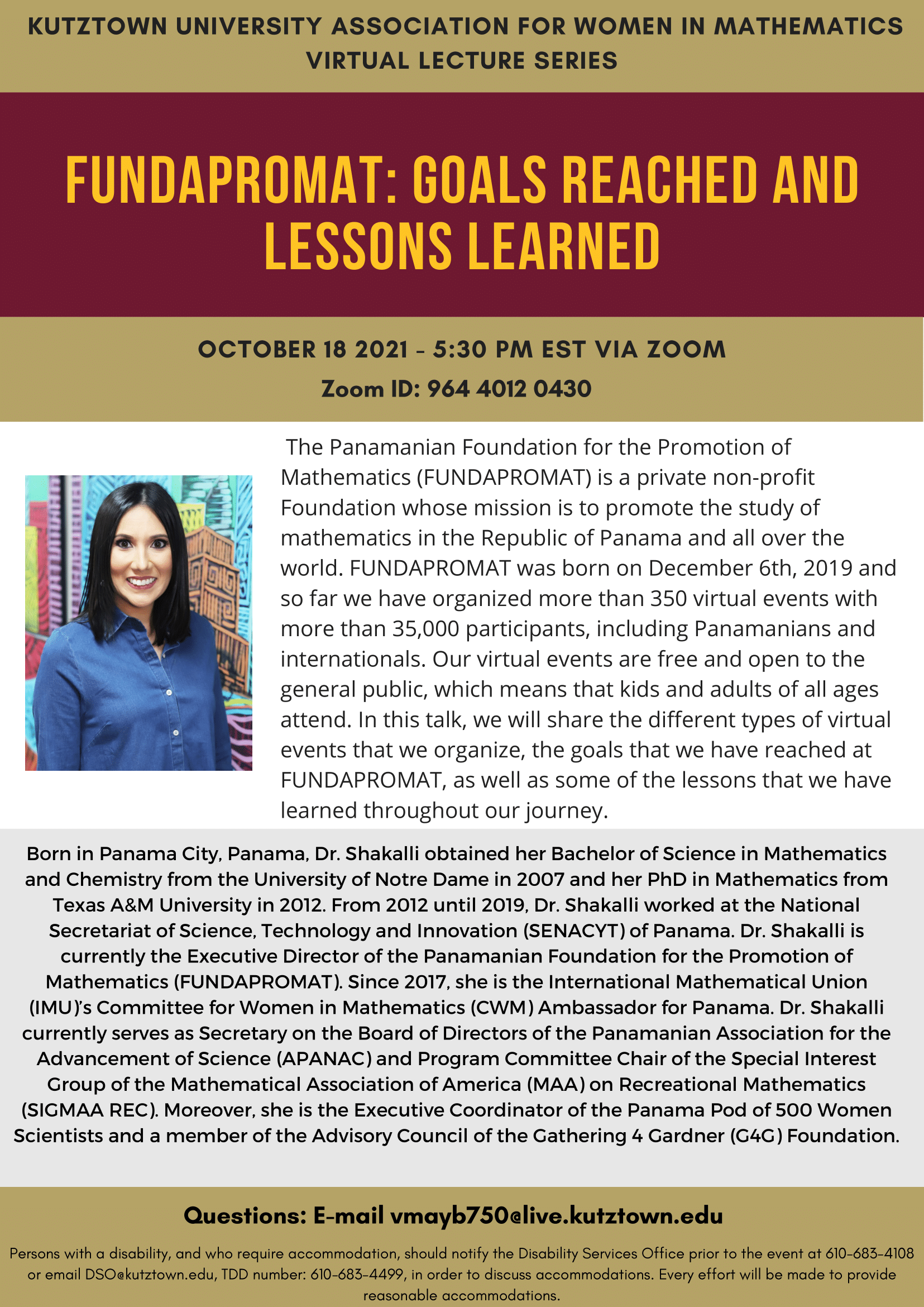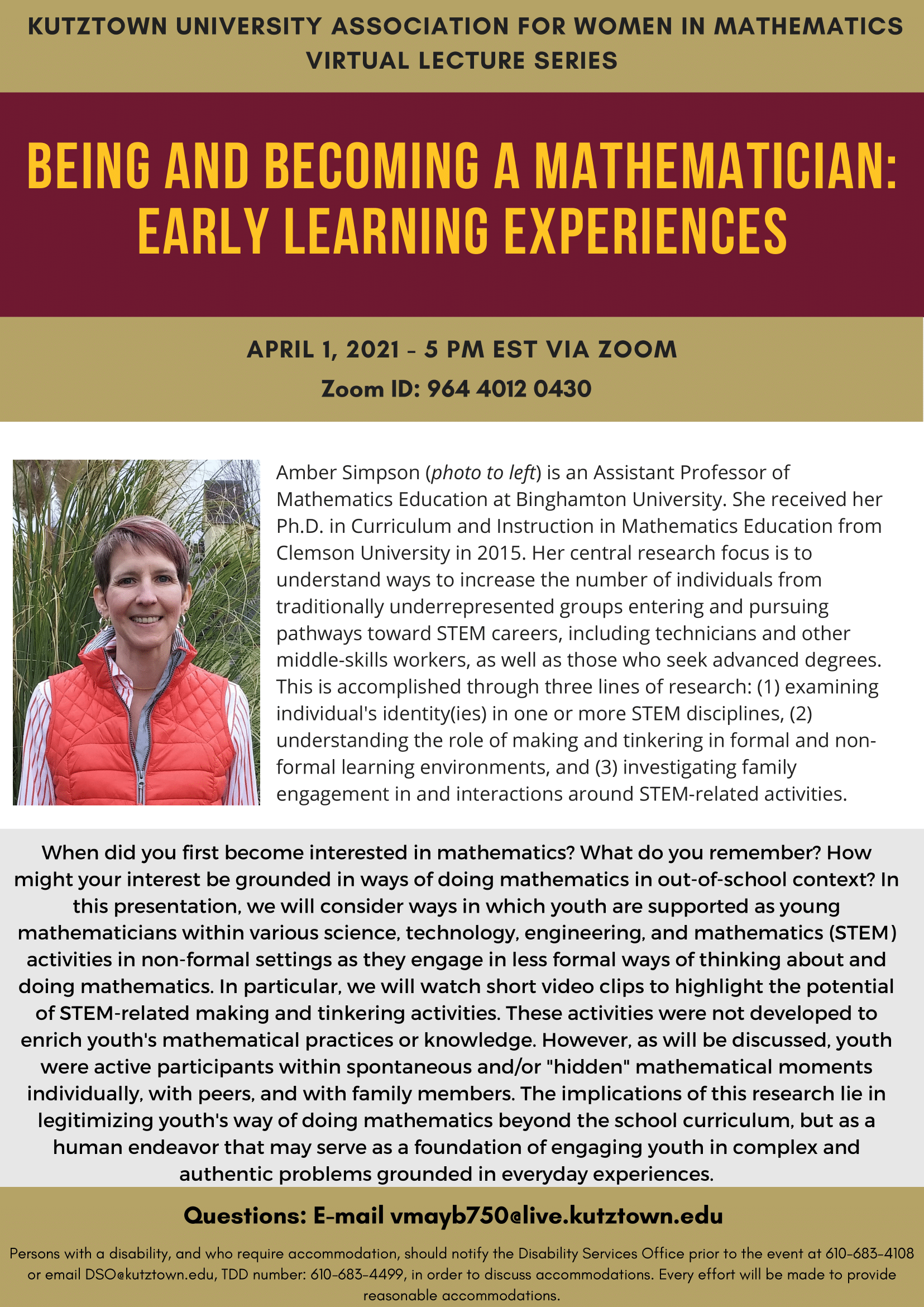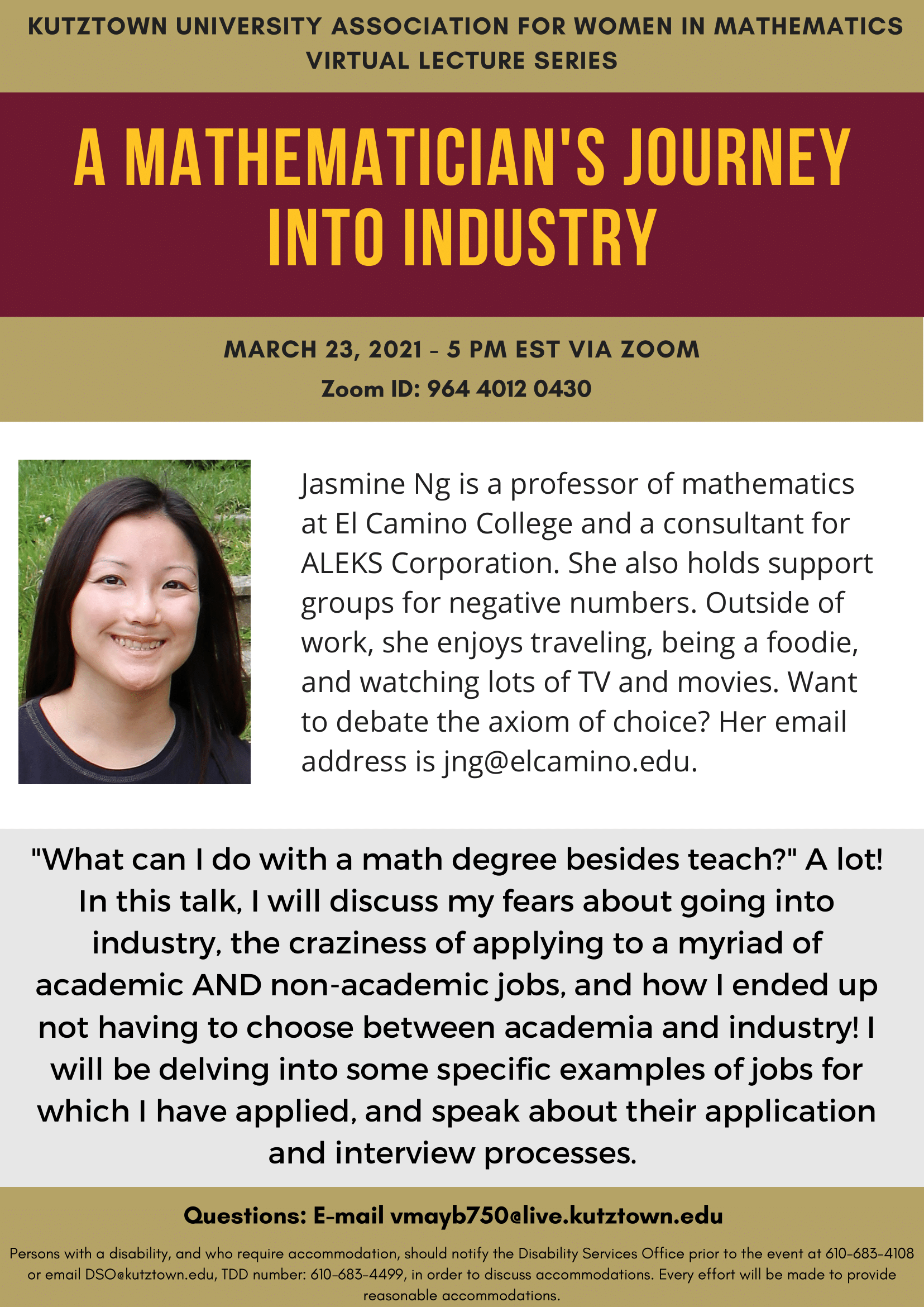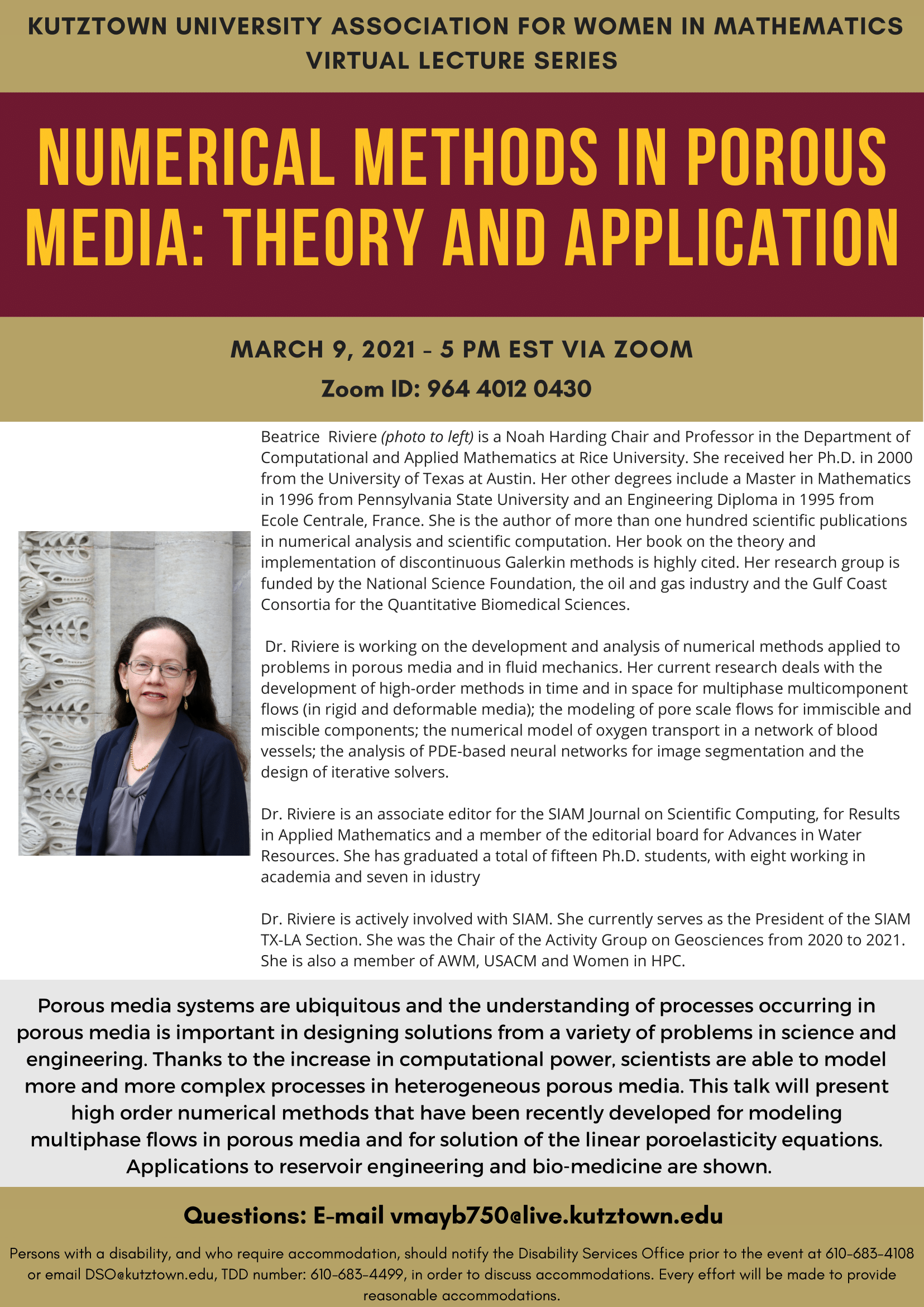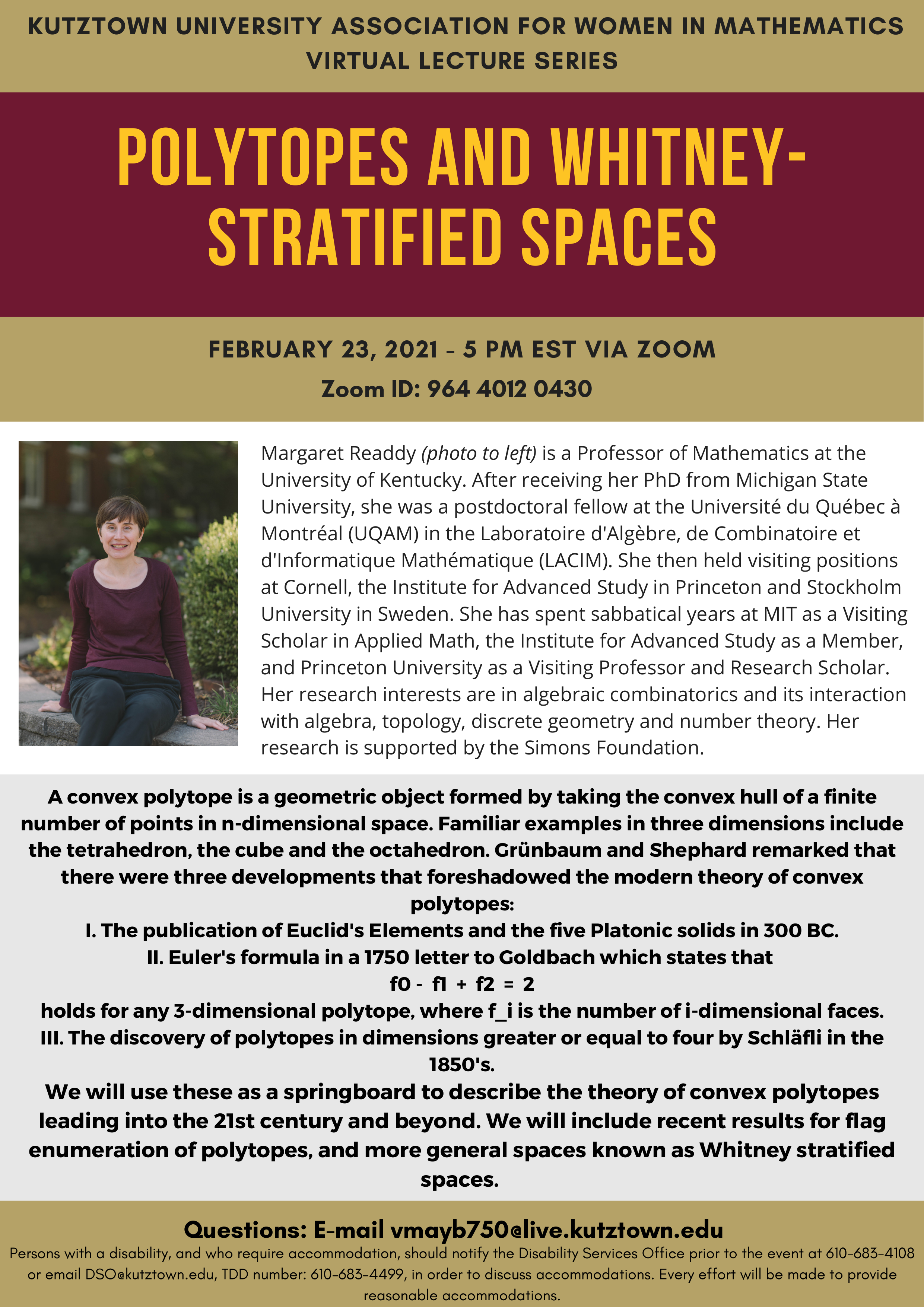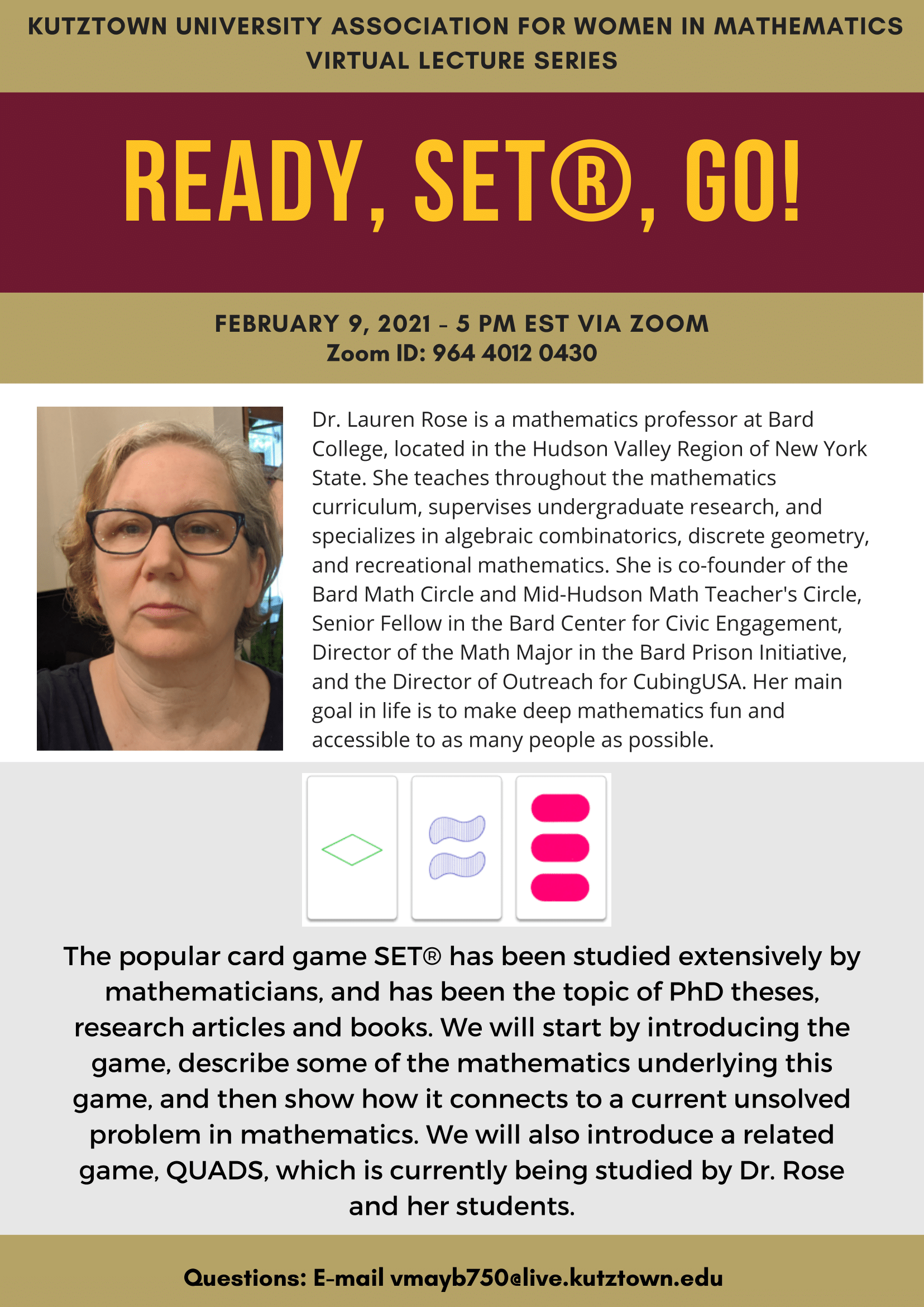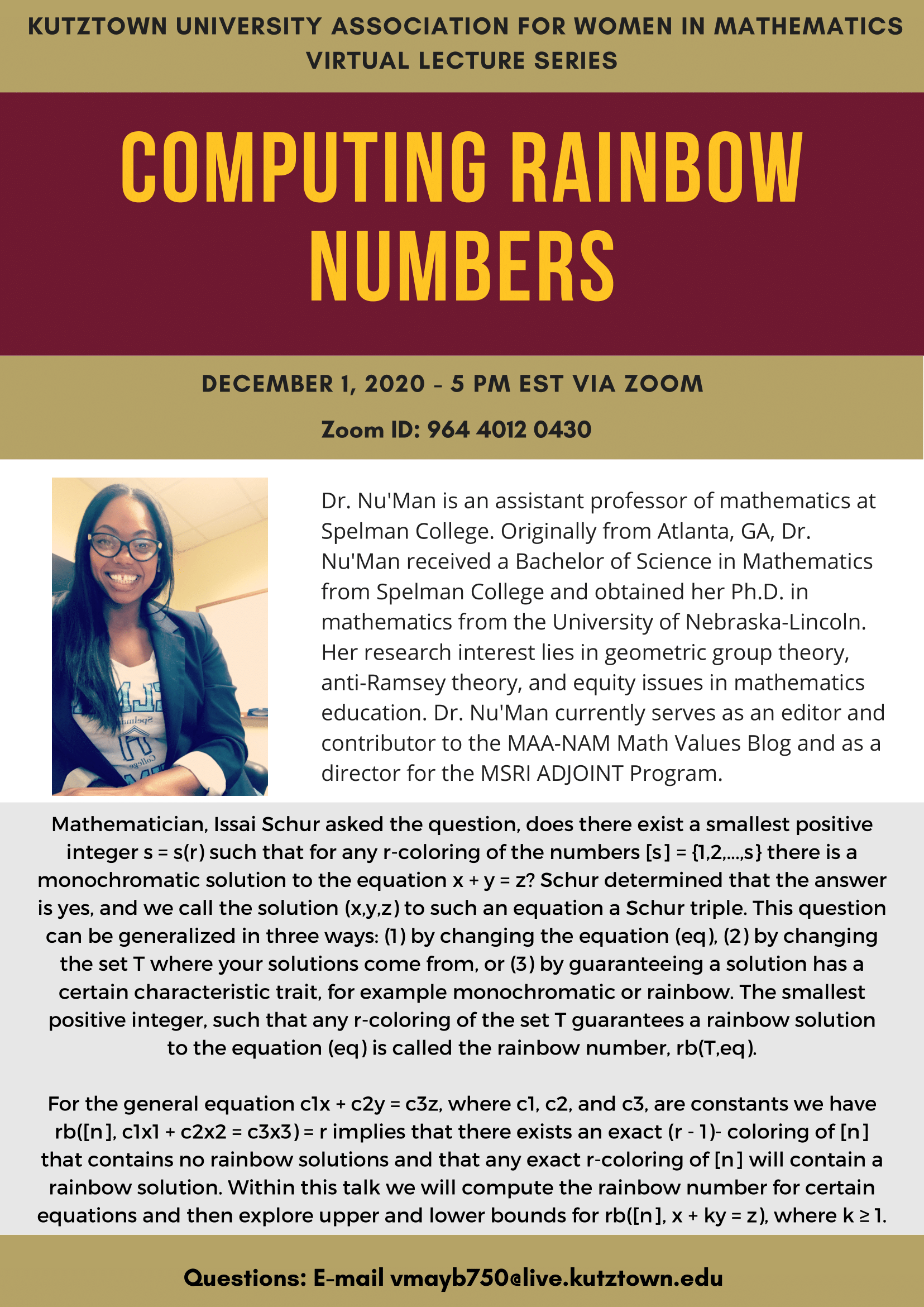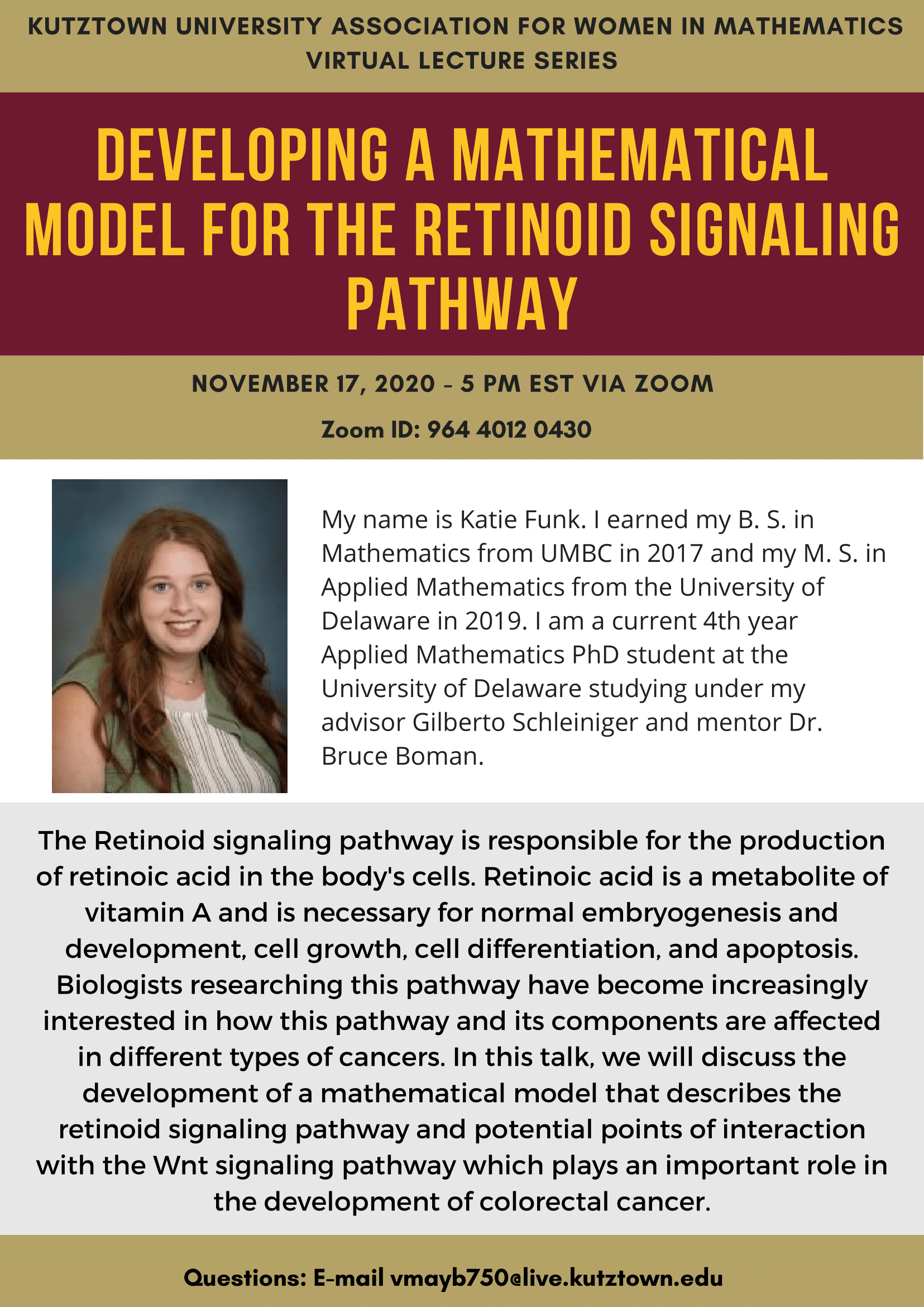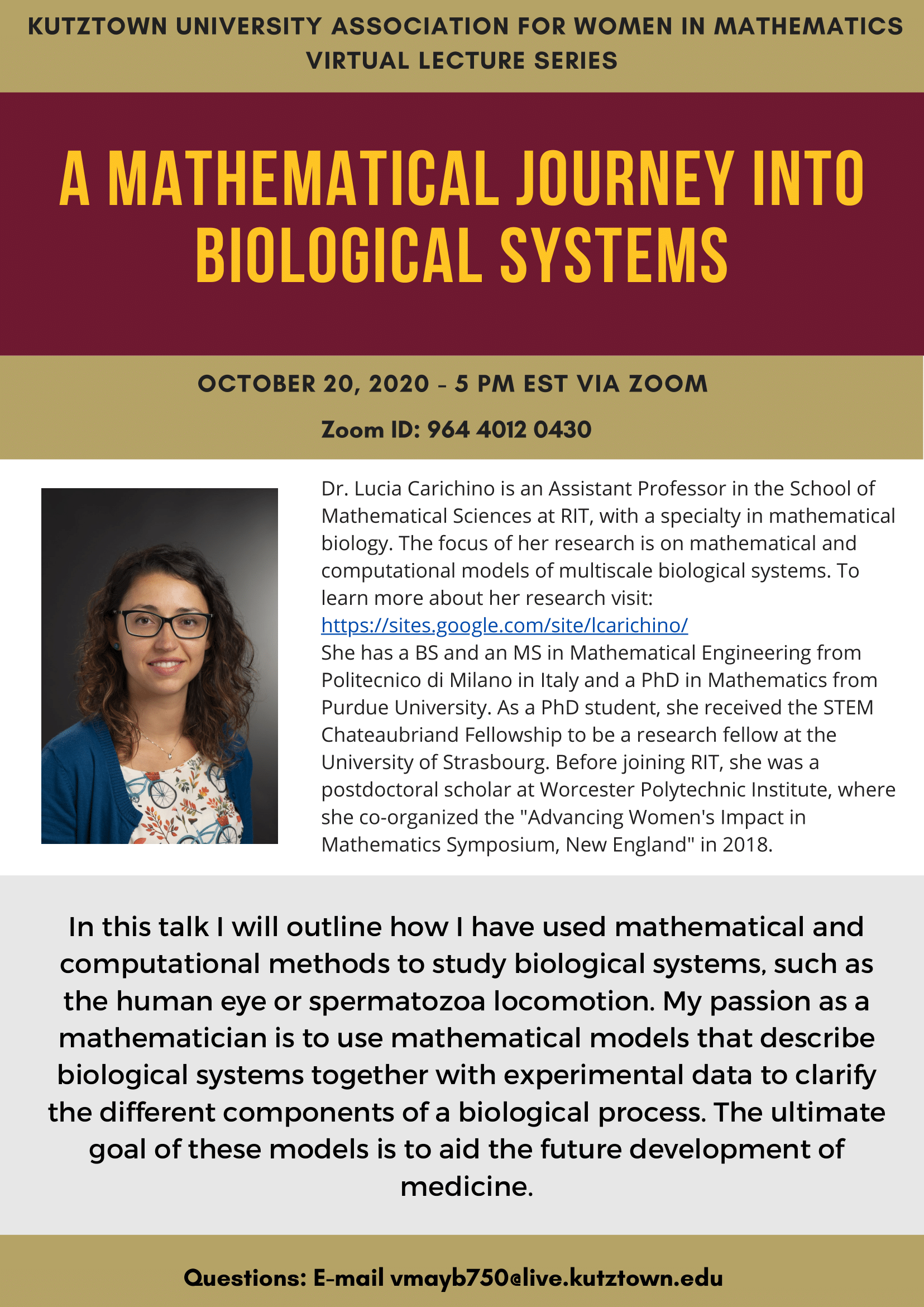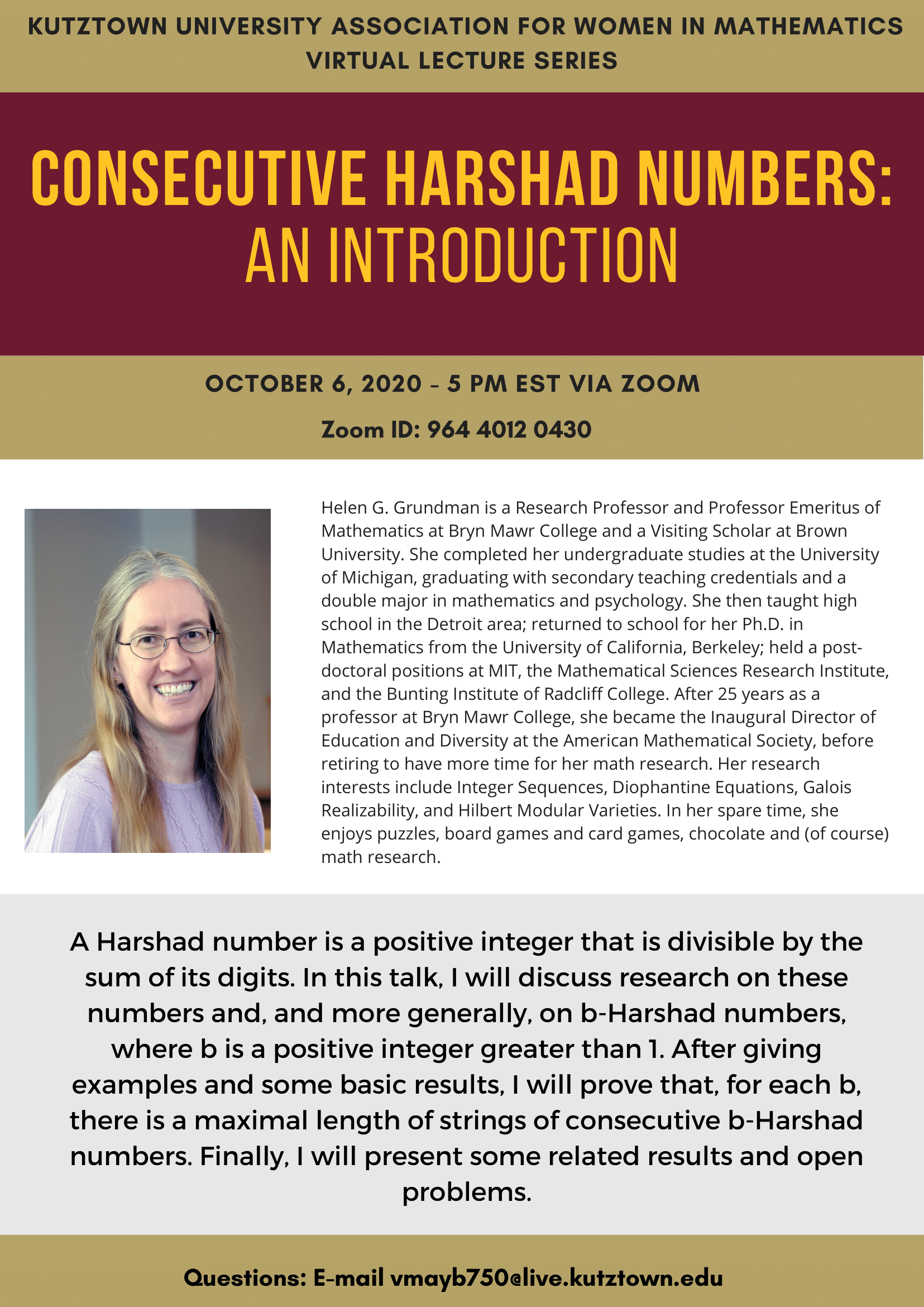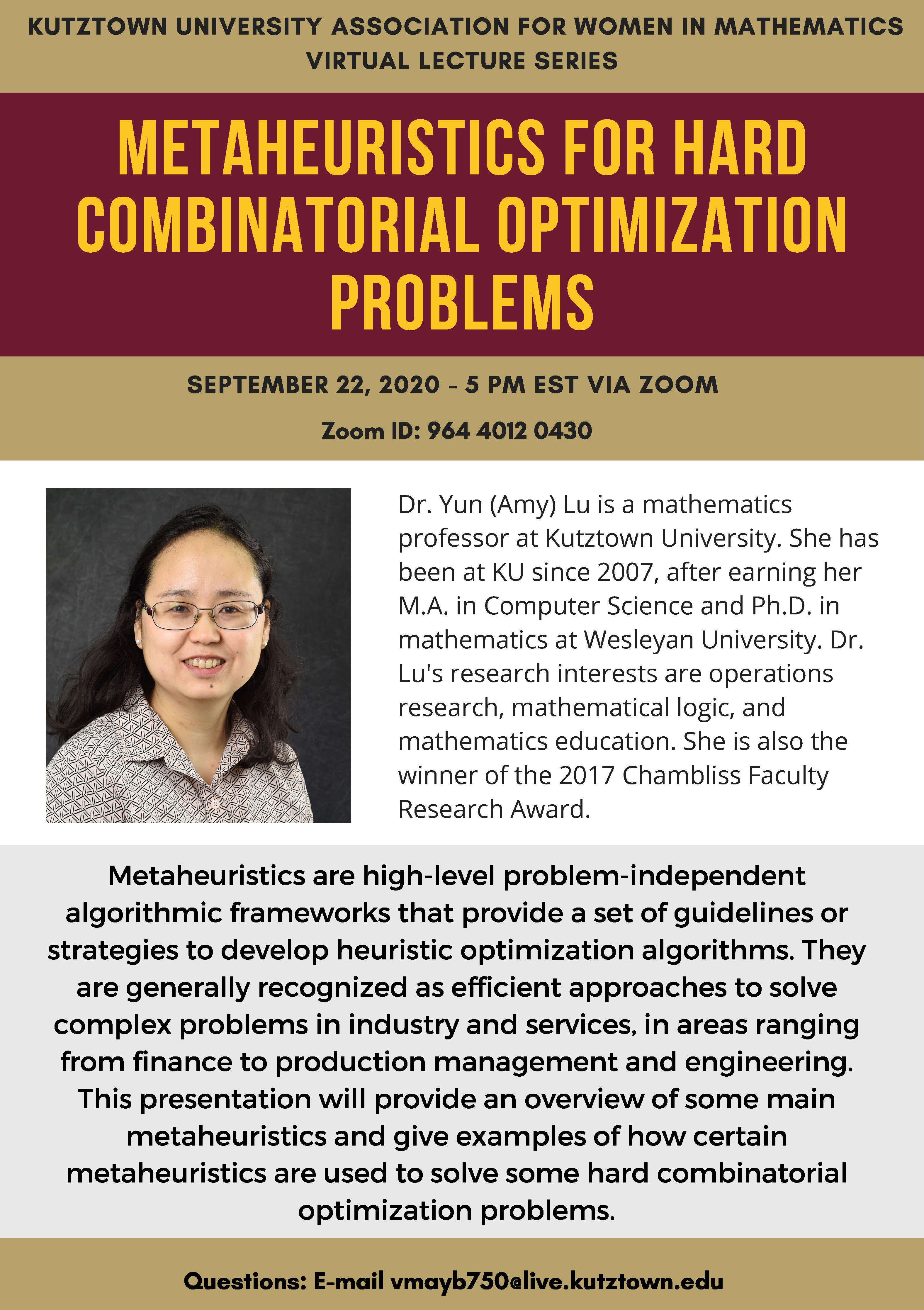Research Seminar
Talks about mathematics research being conducted by faculty and/or students from KU or other universities.
2021
Mr. Nate Benjamin, Iowa State University Ph.D. Candidate
"Schurian Association Schemes Obtained from GU(n,q) Acting on Isotropic Vectors"
Tuesday, December 7 at 2:00 pm in Lytle 214
AWM Virtual Research Lecture SEries
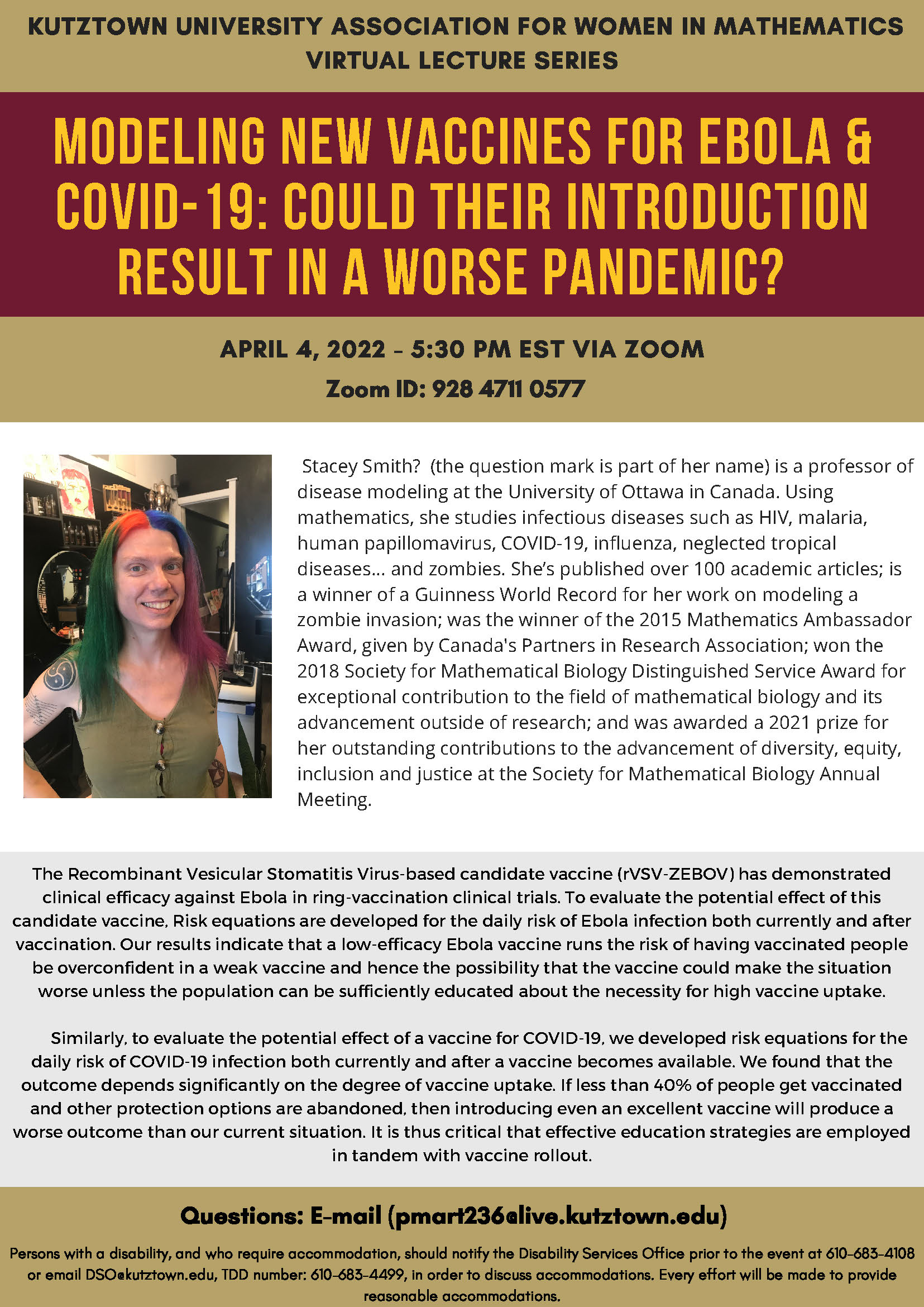
Modeling New Vaccines for Ebola & Covid-19: Could Their Introduction Result in a Worse Pandemic?
April 4, 2022 at 5:30pm
2018-2019
- Dr. Brooks Emerick: "MPI 2018 - Mathematical modeling of blood flow through the heart"
- Dr. Eric Landquist: "How to Create an Elo-Based Sports Ranking and Prediction Model"
- Dr. Wing Hong Tony Wong: "A disguised random walk problem"
- "Open Problems for Senior Seminar and Undergraduate Research"
2017-2018
- Dr. John Botzum (KU): "The Phi-bonacci Sequence"
- Dr. Brian Kronenthal (KU): "Algebraically Defined Graphs in Two and Three Dimensions"
- Dr. Jian Cheng (University of Delaware): "Signed Graphs: Flows and Embeddings"
- Dr. Eric Landquist (KU): "A Card Trick, A Microsoft Interview Question, and Discrete Logarithm Problems"
- Dr. Eric Landquist (KU): "A Card Trick, A Microsoft Interview Question, and Discrete Logarithm Problems"
- Dr. Ju Zhou (KU): "Induced Matching Extendable Graphs"
- Mr. Grant Fickes (KU Math Major): "Edge-Distinguishing Chromatic Number"
- Dr. Fran Vasko (KU): "The No Free Lunch Theorem and Bin Packing"
- Dr. Eric Landquist (KU): "Making Complexity Theory Less Complex"
- Dr. Ju Zhou (KU): "Perfect Matching Transitive Graphs"
- Dr. Brooks Emerick (KU): "Discrete Host-Parasitoid Modeling with a pinch of Continuity and dash of Graph Theory "
- Open problem session
- Organizational meeting
2016-2017
- Dr. Janet Fierson & Mr. Eric Frazier (La Salle University): "An interdisciplinary investigation of coloring graphs"
- Ms. Amanda Lohss (Drexel University Ph.D. Candidate): "Tableaux and the Asymmetric Simple Exclusion Process (ASEP)"
- Dr. Brittany Shelton (Albright College): "On God's Number(s) for Rubik's Slide"
- Dr. James Hammer (Cedar Crest College): "Embedding Complete Multipartite Graphs into Smallest Dimension"
- Ms. Shannon Golden (KU Math Major): "Coloring the Integers"
- Dr. Ferdinand Ihringer (University of Regina): "Intriguing Sets in Quadrangles, Hexagons and Octagons"
- Dr. Barry Smith (Lebanon Valley College): "Necklace invariants: tools for analyzing class groups"
- Dr. Joshua Harrington (Cedar Crest College): "Fields Containing Consecutive Elements of Order n"
- Dr. Brian Kronenthal: "REUs and ADGs"
- Organizational meeting
- Mr. Zach Kern (KU Math Major): "An empirical analysis of three population-based metaheuristics for solving the multidimensional knapsack problem"
- Mr. Diego Manzano-Ruiz (KU Math Major): "Vertex Coloring Game on Graphs"
- Dr. Oskars Rieksts and Mr. Andrew Wernicki (KU Dept. of CSIT): "Generic Prime Collatz – an extension and a restriction of Collatz"
- "Graph Theoretic Games"
- "An Introduction to Magma"
- "Problem Session II"
- "Problem Session"
2015-2016
- Dr. Eric Landquist: "The Mathematics of Voting Theory"
- Professor John Botzum: "It Does Matter How You Slice It: The Combinatorics of Pizza-Slicing"
- Dr. Reinier Bröker (Brown University): "Constructing elliptic curves of prescribed order"
- Dr. Gene Fiorini (Muhlenberg College): "Measuring Robustness of the Hudson River Food Web and Symmetric Class-0 Subgraphs"
- Dr. Ju Zhou: "Integer Flows of Graphs and Graph Coloring - Part 2"
- Problem Session
- Problem Session
- Dr. Ju Zhou: "Integer Flows of Graphs and Graph Coloring - Part 1"
- Organizational meeting
- Dr. Fran Vasko: "Gurobi optimization software"
- Math Movie! : "N is a number"
- Ms. Jiao Xu (Kutztown Mathematics Major): "Coinbinatorics"
- Dr. Amy Lu: "The Teaching-Learning-Based Optimization Metaheuristic for Discrete Combinatorial Optimization Problems"
- Dr. Brian Kronenthal: "An Immensely Interesting Integer Sequence"
- Faculty presentations
- Organizational meeting
2014-2015
- Wrap-up and plans for next semester
- Dr. Rajeev Kumar (College of Business): "A Smart Market of Personal Information."
- Still more discussion on the graceful labeling problem!
- Kenneth Zyma (Masters Thesis Defense): "Solving Medium-Scale Instances of the Cable-Trench Problem Applied to the Proposed LOFAR Super Station in Nancay France."
- Even more discussion on the graceful labeling problem.
- More discussion on the graceful labeling problem.
- The second half of the movie, "Counting from Infinity: Yitang Zhang and the Twin Primes Conjecture."
- The first half of the movie, "Counting from Infinity: Yitang Zhang and the Twin Primes Conjecture."
- Review of a proof that all binary trees can be labeled gracefully.
- Dr. Amy Lu: "Adapting the Teaching-Learning-Based Optimization Metaheuristic to the Weighted Set Covering Problem."
- The Graceful Labeling Problem (continued!)
- The Graceful Labeling Problem
- The Graceful Labeling Problem and the k-Equitable Labeling Problem
- k-equitable tree labelings and graceful labeling of trees
- Organizational meeting
- Dr. Greg Schaper (Computer Science): "A Model of Computation for Teaching and Learning C++."
- Dr. Ge Xia (Dept. of Computer Science at Lafayette College): "The Stretch Factor of the Delaunay Triangulation is less than 1.998 ."
- Fixed-Parameter Tractable algorithms
- Dr. Yong Zhang (Computer Science): "Introduction to parametrized algorithms and complexity."
- Fun problem session
- Adib Farah (Computer Science): "Introduction to Big Data"
- Open Mic
- Problem-Solving Session
- Problem-Solving Session
- Dr. Eric Landquist: "Making Cryptanalysis Less Cryptic and Fried Eggs on Friday: Cracking early versions of the UberCrypt stream cipher"
- Dr. Eric Landquist: "Making Cryptography Less Cryptic"
2013-2014
- Professor John Botzum: "Don't Stand So Close to Me or: How I Learned to Stop Worrying and Love the Twin Prime Conjecture"
- Combinatorical Problems (continued)
- Combinatorical Problems
- Dr. Greg Schaper - Problem-Solving Processes
- Dr. Fran Vasko
- Bitcoin Part 4
- Bitcoin Part 3
- Bitcoin Part 2
- Dr. Brian Kronenthal: "Two Perspectives on Generalized Quadrangles"
- Bitcoin
- Dr. Amy Lu: "Homogeneous structures and their reducts."
- Dr. Tony Wong: "A problem on matroid theory by Dominic Welsh."
- Dr. Joshua Goodson: "Orbits of an Action Involving Extra-special Groups."
- Dr. Eric Landquist: "The Hunt for Primes and Perfection and How You Can Win $3000."
- Dr. Greg Schaper (Computer Science): "Conjecture: (P = NP) and (P ≠ NP)."
- Dr. Ju Zhou: "Pancyclicity of Claw-free Graphs."
- More interesting problems in discrete mathematics
- Dr. Tony Wong: "Some interesting problems in combinatorics."
- Dr. Brian Kronenthal: "Generalized quadrangles, algebraically defined graphs, and permutation polynomials: an introduction."
- Faculty presentations of interesting discrete mathematics (research?) problems
- Dr. Eric Landquist: "What is Discrete Math? Making Discrete Math Less Discreet!"








